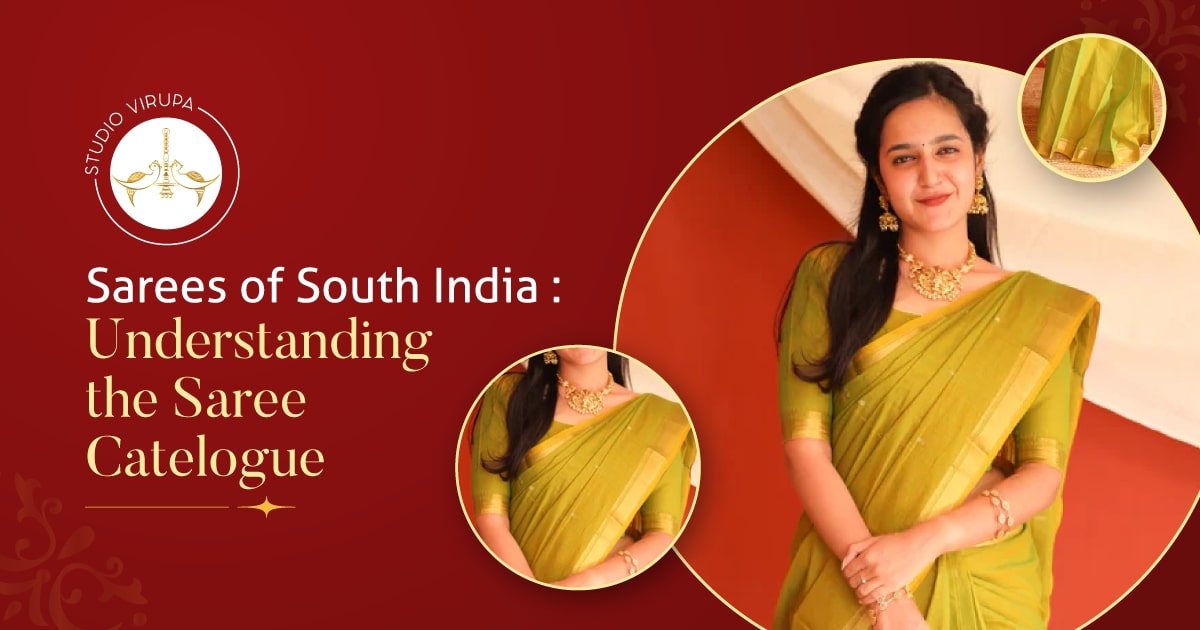Sarees of South India: Understanding the Saree Catalogue
South India boasts a rich textile heritage, with sarees taking center stage. Each region within the South weaves magic into silk and cotton threads, creating stunning sarees that are not just garments but works of art. Dive into this guide to unlock the secrets of the South Indian saree catalogue. We'll explore the most renowned varieties, their unique characteristics, and the stories woven into their very fabric.
The saree, a timeless symbol of Indian grace and elegance, finds its most captivating expressions in the vibrant tapestry of South India. Each region boasts its own unique weaving techniques, motifs, and cultural significance, making the South Indian saree a treasure trove for textile enthusiasts and fashionistas alike. Let's embark on a journey through this dazzling world, unravelling the stories woven into every thread.
A Land of Diverse Drapes: Unveiling the Regional Specialties
-
Kanchipuram: The Queen of Silks
Hailing from the temple town of Kanchipuram in Tamil Nadu, Kanchipuram sarees are renowned for their grandeur and intricate craftsmanship. Woven from pure mulberry silk, these sarees feature zari work (metallic brocade) in elaborate motifs like paisley, rudraksha (holy beads), and temple borders. Their rich colours, ranging from deep maroons and golds to vibrant greens and blues, exude opulence and are often reserved for special occasions and weddings.

-
Mysore Silk: The Epitome of Royalty
-
Kerala Kasavu: The Simplicity of Elegance
The Kasavu saree, a signature weave of Kerala, embodies understated elegance. Made from handwoven cotton with golden zari borders, these sarees are traditionally white or off-white with a hint of cream. The intricate zari work often depicts traditional motifs like mayil (peacock) and aalarum (temple elephant). Kasavu sarees are a symbol of purity and are widely worn during festivals and religious ceremonies.

-
Pochampally: A Celebration of Geometry
Woven in the Pochampally town of Telangana, these sarees are renowned for their vibrant geometric patterns created using the ikat dyeing technique. The intricate designs, often featuring squares, checks, and stripes in contrasting colours, create a mesmerising visual effect. Pochampally sarees are typically made from silk or cotton, making them comfortable and versatile for everyday wear.

-
Chettinad: A Legacy of Colorful Tales
Hailing from the Chettinad region of Tamil Nadu, Chettinad sarees are known for their vibrant colours and bold geometric patterns. Traditionally woven from cotton, these sarees feature broad zari borders and pallu adorned with intricate motifs like peacocks, paisleys, and human figures. Chettinad sarees are a vibrant celebration of tradition and are perfect for adding a touch of cultural flair to your wardrobe.

Beyond the Weave: Understanding Saree Design Elements
-
Fabric: South Indian sarees come in a variety of fabrics, including silk, cotton, and blends. Silk sarees exude luxury and are ideal for special occasions, while cotton sarees offer comfort and breathability, making them perfect for everyday wear.
-
Motifs: Each region boasts its own unique set of motifs woven into the sarees. These motifs often carry cultural and symbolic significance, with some representing prosperity, fertility, and divine blessings.
-
Borders: The borders of a South Indian saree play a crucial role in its design. From the intricate zari work of Kanchipuram sarees to the broad, colourful borders of Chettinad sarees, each border style adds a distinct character to the drape.
-
Pallu: The pallu, or end piece of the saree, is often the most ornate part. It features elaborate designs and motifs that draw the eye and add a touch of grandeur to the saree.
Wearing the Legacy: Draping Styles and Modern Interpretations
The way a saree is draped can vary depending on the region and personal preference. However, the basic principles remain the same. South Indian sarees are typically draped in the style known as the "Iyengar" drape, which creates a sleek and elegant silhouette.
Modern fashion has embraced the South Indian saree, incorporating it into contemporary styles. Experiment with different blouse designs, like sleeveless or peplum blouses, to create a more modern look. Pair your saree with statement jewellery and footwear for a touch of personal flair.
A Treasure Trove for Every Occasion
South Indian sarees offer a vast array of styles and designs to suit every occasion. Whether you seek the grandeur of a Kanchipuram saree for a wedding or the comfortable elegance of a Kerala Kasavu for a festival, there's a South Indian saree waiting to be discovered.
Conclusion: A Celebration of Heritage
South Indian sarees are more than just garments; they are living testaments to a rich textile heritage and vibrant culture. By understanding the regional specialities, design elements, and draping styles, you can embark on a journey of cultural appreciation and personal style exploration. So, delve into the world of South Indian sarees, embrace the intricate weaves and captivating colours, and drape yourself in a legacy of timeless elegance.
Here are some additional tips for exploring South Indian sarees:
-
Visit local weavers: Immerse yourself in the rich tradition by visiting weaving communities and witnessing the sarees being crafted firsthand.
-
Support sustainable practices: Look for sarees made using natural dyes and ethical production methods.
-
Embrace pre-loved sarees: Explore vintage stores and online marketplaces to discover unique and pre-loved South Indian sarees.
-
Learn the art of draping: Enroll in a saree draping workshop or watch online tutorials to master the art of draping a South Indian saree flawlessly.
With a little exploration and appreciation, South Indian sarees can become a cherished part of your wardrobe, connecting you to a vibrant cultural heritage and allowing you to express your unique sense of style.
Studio Virupa: Where Tradition Meets Modern Elegance for the Discerning Woman
Studio Virupa isn't just another ethnic wear boutique. We cater to the modern woman who cherishes her heritage and desires a wardrobe that reflects it. Our exquisite collection of women's traditional attire seamlessly blends contemporary aesthetics with time-honoured traditions.
Luxury Fabrics, Exquisite Craftsmanship:
Imagine yourself draped in a masterpiece. At Studio Virupa, that's exactly what you get. We use only the finest fabrics, including the world-renowned silks of Banaras and Kanchipuram. Each piece is a testament to the meticulous handwork and embroidery of skilled artisans.
Beyond the Saree:
Our love for Indian craftsmanship extends far beyond the saree. Discover a world of chic Anarkalis, perfect for a touch of effortless elegance. Explore our collection of classy kurtis, which are ideal for everyday wear or festive occasions. And for those grand entrances, we offer stunning lehengas that exude timeless beauty.
For Every Occasion:
Whether you're seeking a statement piece for a wedding, a sophisticated outfit for a formal event, or simply elegant attire for everyday wear, Studio Virupa has something for you. Our timeless designs will elevate your wardrobe and enhance your natural beauty.
Embrace Your Heritage, Embrace Your Style:
At Studio Virupa, we believe that tradition and modernity can coexist in perfect harmony. Explore our collection and discover pieces that allow you to celebrate your heritage while expressing your unique style. Visit us today and embark on a journey of cultural appreciation and personal expression.
Conclusion
The South Indian saree catalogue is a treasure trove of vibrant colours, intricate designs, and time-honoured craftsmanship. From the regal Kanjeevaram to the understated elegance of Mysore silk, each saree tells a story and reflects the cultural tapestry of the region. So, the next time you drape a South Indian saree, remember the artistry and heritage it embodies. You're not just wearing a garment; you're carrying a piece of South Indian tradition.
FAQs
- What are the most popular types of South Indian sarees?
Popular South Indian sarees include Kanchipuram (Kanjeevaram) sarees, known for their rich silk and intricate designs; Mysore silk sarees, famous for their simplicity and elegance; Chettinad sarees, characterised by their bold patterns and vibrant colours; Pochampally sarees, renowned for their unique ikat weaves; and Kasavu sarees from Kerala, distinguished by their white and gold combination.
- How do I choose the right South Indian saree for a special occasion?
For special occasions, consider the type of event and the level of formality. Kanchipuram sarees are ideal for weddings and festive events due to their grandeur. Mysore silk sarees work well for both formal and semi-formal events. Chettinad and Pochampally sarees are great for traditional functions, while Kasavu sarees are perfect for simple yet elegant celebrations.
- What should I look for when purchasing a Kanchipuram saree?
When purchasing a Kanchipuram saree, check the silk quality and whether the zari (gold or silver thread) works. Authentic Kanchipuram sarees are made of pure mulberry silk and have intricate designs. Look for the silk mark label, which certifies the purity of the silk. Pay attention to the craftsmanship and the overall finish of the saree.
- How can I identify authentic Mysore silk sarees?
Authentic Mysore silk sarees are made from high-quality pure silk and have a distinct sheen. They often feature minimalistic designs with a focus on the border and pallu. Look for the Government Silk Mark and the GI (Geographical Indication) tag, which indicate authenticity. The saree should feel smooth and lightweight yet luxurious.
- How should I care for my South Indian silk sarees to ensure their longevity?
To care for your South Indian silk sarees, store them in a cool, dry place away from direct sunlight. Use a muslin cloth to wrap the saree before storing it. Avoid hanging heavy silk sarees to prevent the fabric from stretching. Dry clean the sarees to maintain their colour and texture. For regular maintenance, air them out occasionally and refold them to prevent creases from sitting in one place.

 Xmas SpeedShip
Xmas SpeedShip